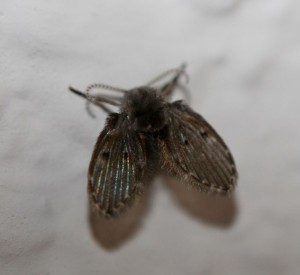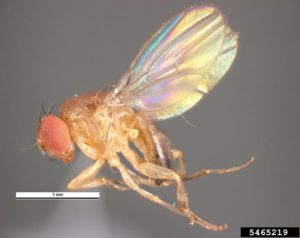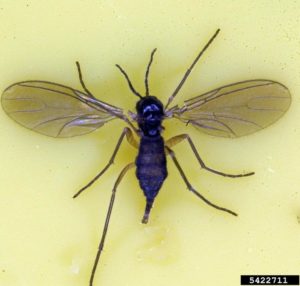General Information
Many small flies (<1/4”) are found in association with humans and their environment. However, there are four species of flies that are of concern because they are the most common of the small flies, often associated with food preparation areas and are capable of carrying disease-causing organisms.
Identification
Drain flies are also called moth or sewage flies. Adult female drain flies deposit eggs in in drains, garbage disposals, grease traps, and even sewage treatment plant filters. Larvae feed on bacteria mats inside drains and on decaying organic matter in a variety of sites, and can survive in extremely wet conditions. Most infestations are generated from within the school, including food service areas and custodial closets. Drain flies can carry bacteria and other microorganisms from egg-laying sites to food and food contact surfaces and high populations should not be tolerated.
Fruit flies (Drosophila species) are often present in the kitchen areas and food service areas of schools. They are also called pomace or vinegar flies, and are sometimes confused with other small flies, especially humpbacked flies (Family Phoridae). Fruit flies are strongly attracted to, and breed in, fermenting fruits or liquids. Large numbers of fruit flies may indicate unsanitary conditions including spilled or spoiled fruit and vegetables; poorly maintained garbage containers; accumulation of organic matter around drains, grout or broken tiles; and wet areas under and behind equipment.
Larvae of fungus gnats feed on fungi and plant rootlets, and are most commonly found emerging from the soil of potted plants. Fungus gnats typically do not harm healthy plants but their presence can be an indication of over-watering. High populations may feed on plant roots and adversely affect plant growth, especially young plants, if preferred food, including microorganisms, is not available. Fungus gnats may also carry plant disease organisms from one plant to another.
Phorid flies feed on, and breed in, wet areas containing decaying organic matter. Common breeding sites include drains, garbage areas, animal carcasses, and contaminated soil. Phorid flies may also be associated with decaying organic matter in the bottoms of garbage cans, or trapped in cracked floor tiles or under the bases of kitchen equipment. Chronic, heavy infestations of phorid flies may be a result of a broken, underground sewage line. When other causes have been ruled out or corrected and a phorid fly problem persists, sewage lines should be inspected by a plumber. Any breaks should be fixed and contaminated soil removed to eliminate the infestation.
None of these small flies bite, although their presence may sometimes be associated with employee complaints of bites. Any association of these flies with bites is incidental, or possibly psychological in origin (e.g., fungus gnats look like very small mosquitoes, and may induce people to imagine that they are being bitten).
| Image | Description | Where to Look |
| Drain flies, Moth flies, Filter flies (Psychoda spp.)
|
Adults vary in color from yellowish-gray to brownish-gray to black, depending on the species. They are approximately 1/8 inch long. These small, delicate, fuzzy flies are covered with dark, tiny hairs on the wings and body. The wings are held roof-like over the body. Most wing veins are parallel. | These flies are found in areas of high moisture — in and around drains, septic systems, grease traps and other areas containing very moist organic solids. Adults are attracted to the gelatinous mass that develops in these areas to lay eggs. Larvae feed on algae, bacteria, fungi and the sludge in this film. Infestations could indicate a cracked or damaged sewer pipe or a dry drain trap. |
| Fruit fly, (dark-eyed) Drosophila spp.
|
The gnat-sized adults are up to one-eighth of an inch long and typically have tan-colored bodies and red to brown eyes. | Also known as vinegar flies, fruit flies are attracted to sweet or fermented liquids such as liquor, syrup, soda pop and vinegar, in addition to ripening/rotting fruit. It takes less than a week for a fruit fly to develop from egg to adult, so problems can quickly arise. |
| Fungus gnats (Bradysia spp)
|
Adults are black, brown or yellowish and occasionally brightly colored. The wings usually are smoke colored or patterned. The flies are approximately 1/8 inch long. They are slender to moderately robust. They are long-legged, mosquito-like flies. | Adults are found near larval food material, such as moist soil with fungi and decaying organic matter. Indoors, they are almost always associated with atriums and soil of over watered potted plants. May be found around water leaks or water-soaked materials capable of growing fungi. Outdoors, they are found in mulched areas and the associated soil, accumulations of dead leaves, old pallets, compost piles, etc. |
| Phorid fly (Phoridae spp)
|
Adults are dark brown with a hump on the thorax, dark eyes. Wings have several short, thickened veins. Adults run rapidly rather than fly and can occur in large numbers. | Drains, sewage, damp organic materials, rotting fruits and vegetables, garbage, poorly stored meats, cracks in floors and underneath kitchen equipment. They often fly and walk with a quick, darting motion. |
Suggested Thresholds
More than two flies (of any species) observed per visit, or collected per sticky trap or glue board indicate a need for more thorough inspection of the area to identify and eliminate potential breeding sites. Where employee complaints about fruit flies occur more than once a month, fruit fly traps that use liquid attractants should be employed as a supplement to breeding site elimination. Office complaints of fungus gnats are more difficult to assess, and thresholds should be based on consultations with the campus staff or the IPM committee.
Monitoring and Inspection
Routine visual inspection for fly breeding sites should be made during each IPM service visit. Inspections should be made of tile flooring, under kitchen equipment and floor drains. Sticky cards, UV light traps and glue boards can also be used to monitor drain flies and fruit flies.
Kitchen staff should be trained to inspect incoming produce for fruit flies; infested produce should be discarded or covered and places in cooler or refrigerator until it can be more closely inspected and bad produce culled.
When drain flies or phorid flies are suspected to be emerging from floor drains, a piece of duct tape, or a tent formed from a sticky trap or glue board may be placed over the suspect floor drain. These should be checked within the next day or two for flies.
Indoor plants can be gently lifted and or shaken to determine if fungus gnats are present; yellow or blue sticky traps can also be mounted on stakes placed in potted plants to monitor for fungus gnats.
Indoor (UV light) fly traps should be numbered with the location noted on a list or ideally on a schematic diagram of the facility and dated and initialed each time they are checked or replaced. For drain and fruit flies, ideal placements include locations near plumbing fixtures, dishwashers, under prep tables and in trash or recycling storage areas. Electrocuting type fly traps should not be used in kitchens as exploding insects can contaminate food preparation surfaces. Bulbs on UV light traps should be replaced annually.
Specific monitoring for fruit flies, including fruit fly traps, should not be required on an ongoing basis if the proper management practices are in place to prevent conditions conducive to fruit fly infestation.
Nonchemical Control Measures
Cultural, physical and mechanical management options are the best strategies and include posting notices to encourage the cleanup of spills, proper food storage and trash/recycle handling, elimination of standing water, fixing plumbing leaks, drying mops, emptying mop buckets and inspecting incoming produce and rejecting any infested or overripe produce.
Sanitation/Cultural Control Measures
- Clean areas where food residues may accumulate. Key locations include the undersides of prep counters and around kitchen equipment and fixtures. A steam cleaner may facilitate the cleaning process
- Eliminate breeding sites by sealing cracks, edges around coving, tiles and kitchen fixtures/equipment to eliminate accumulation of organic matter
- Clean up food and drink spills immediately
- Rinse all beverage containers prior to placement in lined recycle bins. Do not store recycled containers for more than seven days
- Inspect incoming fruit and vegetables for the presence of fruit flies. Over-ripe produce is most suspect and may be harboring eggs and larvae even if adults are not evident
- Clean drains/traps and strainers at least twice per week to eliminate residues that encourage fly development
- Ensure that all P-traps are kept full of water to prevent insects in sewage system from entering building through floor drains
- Adjust seasonal watering schedules for potted plants to allow soil to dry between watering. Plants tend to be over-watered in fall and winter months, leading to fungus gnat population increases
Physical/Mechanical Control Measures
- Repair plumbing leaks and ensure no standing water on floors in food preparation areas
- Discard over-ripe fruits, vegetables and store in plastic bins in cool storage room
- Use liners for waste containers and empty and clean these receptacles daily
- Maintain positive air pressure in kitchens and cafeterias to discourage fly entry
- Install air or strip curtains over the exterior entrances to kitchen areas
- Install physical barriers in drains to inhibit the evaporation of trap seals and provides a non-mechanical physical barrier to sewer gas, raw sewage, viruses, bacteria, insects and vermin.
- Place exterior trash cans, recycle bins and dumpsters at least 50 feet from kitchen or other building entries
- Check for and repair sewage line leaks
- Use traps baited with vinegar, juice or soft drinks as supplement to sanitation to capture fruit flies
- Use non-toxic fruit fly traps to capture adult fruit flies
Biological Control Measures
- Use biologically based (microbial) drain and surface cleaners regularly to remove food residues from floors, covering, the underside of kitchen fixtures and equipment and drains. Foam-based formulations are particularly effective under equipment and in drains.
- Use nematode or microbial pesticide (e.g., Bacillus thuringiensis) formulations to treat fungus-gnat infestations in potted plants.
Chemical Control Measures
Pesticide options have limited value and are rarely required for the management of drain and fruit flies and other small flies. Chemicals are sometimes used to “knock down” adult fruit flies or to help “break” the life cycle and prevent the emergence of adults but will not provide long-term control.
For control of fungus gnats in indoor plantscapes, use IGR or conventional pesticides labeled for treating potting soil. Where practical, plants should be transported outdoors for treatment and returned indoors when dry.
Surfaces around floor drains may be spot treated (areas less than two feet-square) with residual insecticide if necessary.
Always read and follow the label. The label is the law. Pesticides must be used in accordance with federal, state and local regulations. Applicators must have proper credentialing to apply pesticides and should always wear personal protective equipment (PPE) as required by the pesticide label during applications. All labels and Safety Data Sheets (SDS) for the pesticide products authorized for use in the IPM program should be maintained on file.
When using pesticides in schools, appropriate notification and waiting intervals should be observed. For more information contact your state regulatory agency.
Evaluation Methods
Populations of small flies, especially in kitchens, can fluctuate greatly in a short period of time. Follow-ups to service calls for small flies should be conducted approximately one-week following treatment.
Compiled by Janet Hurley, Mike Merchant




